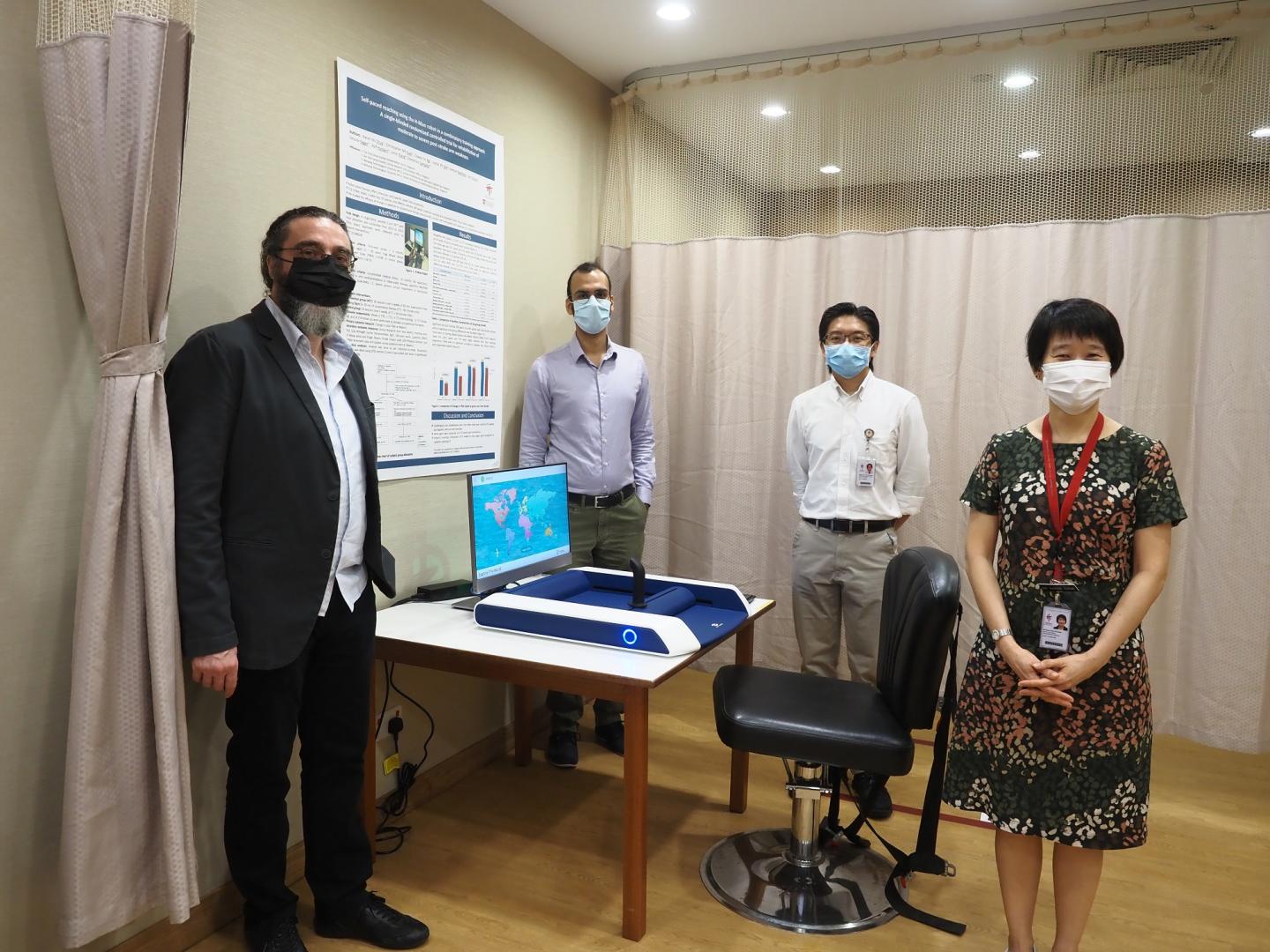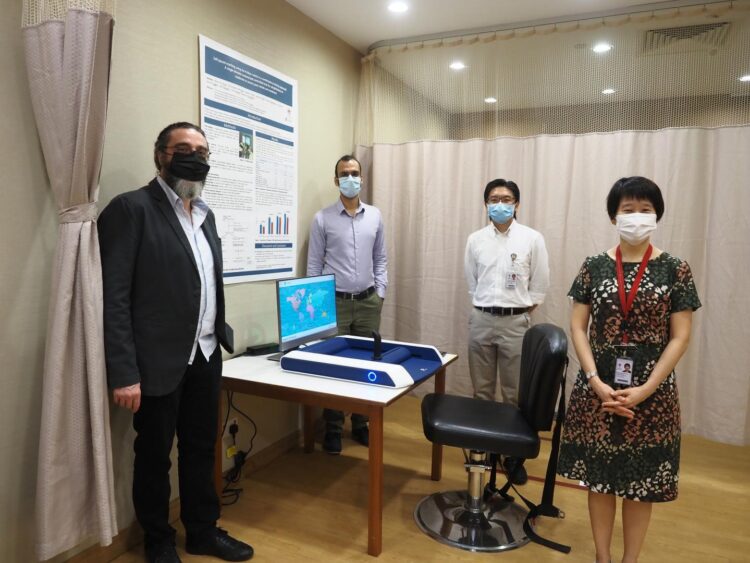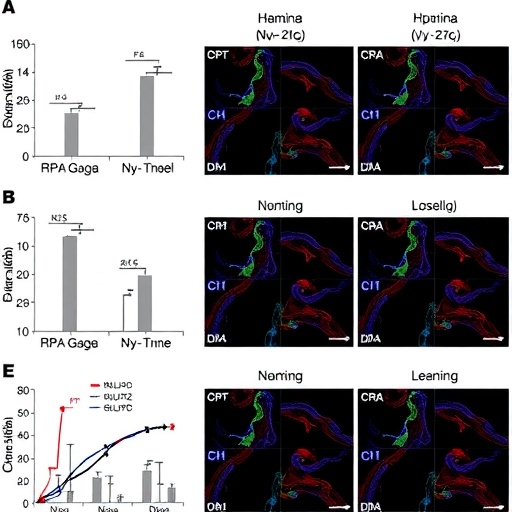
Credit: Tan Tock Seng Hospital
A new portable arm rehabilitation robot will help patients to carry out robot-aided therapy at home, allowing them to perform intensive exercises without visiting hospitals or clinics, which can possibly reduce the risk of exposure to infectious diseases such as COVID-19. The robot can also be used in hospitals and outpatient facilities such as nursing homes and clinics.
The compact robot, known as the H-Man, has demonstrated its efficacy in helping patients improve their upper-limb mobility in a clinical trial involving 60 stroke patients undergoing rehabilitation therapy.
Currently, most robots that are used for rehabilitation purposes weigh up to 70 kgs, require special reinforced housing, are very costly, and are located at hospitals where their operation is managed by occupational therapists.
In comparison, H-Man weighs 14 kgs and can be placed on a normal table. Consisting of a handle shaped like a joystick and a large screen, the patient performs prescribed tasks shown on the screen such as playing a game, while the robot evaluates his or her progress and sends feedback to therapists wirelessly.
The smart robot was developed over eight years by scientists from Nanyang Technological University, Singapore (NTU Singapore) in collaboration with rehabilitation physicians and occupational therapists from the Centre for Advanced Rehabilitation Therapeutics (CART) at Tan Tock Seng Hospital (TTSH) Rehabilitation Centre.
With the successful completion of the clinical trials, the technology was commercialised and spun off into ARTICARES by NTUitve, NTU’s enterprise and innovation company. In the short span of three years, ARTICARES has grown into a successful company with strong international presence including in Australia, Germany and China.
Leader of the NTU research team, Associate Professor Domenico Campolo, co-founder of ARTICARES, said their initial aim was to develop an affordable and portable robot that post-stroke patients could use for rehabilitation therapy at home or in community-based settings at their own pace with minimal supervision, as a complement to conventional therapy.
“With an ageing population in Singapore, we can expect to see more elderly people with upper-limb movements affected by stroke or other injuries,” said Assoc Prof Campolo, who is the Director of the NTU Robotics Research Centre. “Our smart robot is designed to allow patients to practise in the comfort of their own home with minimal help from therapists. It also improves the reach of rehabilitation physicians and occupational therapists, as they can supervise more patients this way than through one-to-one visits at the hospital.”
Adjunct Associate Professor Karen Chua, Senior Consultant at the Department of Rehabilitation Medicine, TTSH and at NTU’s Lee Kong Chian School of Medicine, who led the clinical trials for the H-Man from 2014 to 2018, said, “The machine targeted smart intensive, training to help stroke patients regain sensorimotor control and strength, and translate these to functional use of their arms in combination with conventional therapy by occupational therapists. Furthermore, lasting gains up to 19 weeks were observed after training, implying sustainability of the training and this was associated with high levels of patient safety and self-reported satisfaction in trained subjects. Potential to upskill rehabilitation professionals and enhance their productivity are also plus points to use robots in the clinic.
“As ARTICARES is locally headquartered, this has facilitated our next phase of collaboration, to foster a smooth and effective translation to the clinic,” said A/Prof Chua.
Enabling continued rehabilitation care in the community
Chief Executive Officer and co-founder of ARTICARES Dr Asif Hussain, said that while there are other technological solutions for motor rehabilitation, most of them still require the patient to be present at the hospital and under constant supervision.
“When the patient is in hospital, they can receive therapy and quality care daily. However, once they are discharged, there will be gaps in between each hospital therapy session with limited to no options to continue therapy with the same quality, intensity and frequency from outpatient settings” said Dr Hussain, a former research fellow at the NTU Robotics Research Centre.
“For post-stroke or brain injury patients, it is challenging for them to make the journey from home to hospital and back, so they often require a family member or helper to assist them. Our hope is that the H-Man robot can help bridge this gap by allowing them to do therapy in the nearby day rehabilitation centre, clinic or even at home, since we have clinically demonstrated its therapeutic efficacy and safety.”
In the clinical trials, patients using H-man successfully improved in their mobility at the same rate as conventional therapy. An assessment of their Fugl-Meyer Assessment (FMA) scores showed an average increase over 6 weeks of training of 46% for H-Man compared to conventional therapy and long-term retention of learning observed at follow-up stage with FMA was also on average observed to be 20% higher. Four of the subjects, successfully trained with the H-Man in their own home for three days, this time, under the supervision of their carers.
How the H-Man works
Specially designed games for helping patients stay motivated and learn in a fun way are displayed on the H-Man screen. Patients play the games using a joystick-shaped handle that can sense the patient’s arm strength and increase or decrease the difficulty of performing tasks in a lot of different therapeutically beneficial ways, based on the patient’s individual needs, thus helping them to relearn sensorimotor control and apply it to activities for daily living.
The device is easy to set up and use and H-Man can be equipped with a variety of soft-touch handles, including sensor-embedded handles, to suit the needs of the user and his/her therapist.
To control the games and programming on the H-Man, a digital platform called CARE has been designed based on inputs and feedback from TTSH rehabilitation physicians and occupational therapists. An automatic reporting feature also allows clinicians to track their patients’ recovery remotely.
Moving forward, ARTICARES plans to further harness technologies such as robotics and AI to improve healthcare delivery and to improve the lives of people.
“It does not stop here. It is our vision to make rehabilitation more accessible and affordable so that we can reach out to as many patients as possible and help them maximise their rehabilitation potential. This is now even more important with the current situation we are facing with COVID-19 where social distancing is becoming the new normal. We hope that by using our technologies, they can regain their mobility in a shorter time and resume their normal daily lives. This would not have been possible without the tremendous support from NTU, TTSH and the National Medical Research Council,” adds Dr Asif Hussain.
Dr Alex Lin, Interim CEO of NTUitive, said: “The H-Man by ARTICARES is a prime example of how technologies from the university are successfully being brought from the lab to the marketplace to serve real and pressing needs of society. We are proud to have guided the team through the commercialisation process to make the H-Man available for stroke patients as part of their rehabilitation journey.”
Speaking on the long-standing collaboration between ARTICARES, the National Healthcare Group’s (NHG) Centre for Medical Technologies and Innovations (CMTi), and TTSH’s Department of Rehabilitative Medicine, Associate Professor Thomas Lew, Clinical Director, NHG CMTi; and Group Chief Data and Strategy Officer, NHG, said, “This partnership was first forged when CMTi facilitated a research project between TTSH and NTU to develop a manpower-efficient rehabilitative solution for patients suffering from neurological injuries. It contributed to the successful spin-off of ARTICARES to introduce H-Man to patient care and the research community, both locally and internationally. We will continue to work together on a pipeline of devices for dedicated upper and lower limb rehabilitation, and systems for remote tele-rehabilitation therapy.”
###
Media contact:
Jasmine Singh
Marketing & Communications
ARTICARES Pte. Ltd.
Email: [email protected]
Lester Kok
Assistant Director
Corporate Communications Office
Nanyang Technological University
Email: [email protected]
Ms Charlene Tan
Senior Executive, Communications
Tan Tock Seng Hospital
Email: [email protected]
About Nanyang Technological University, Singapore
A research-intensive public university, Nanyang Technological University, Singapore (NTU Singapore) has 33,000 undergraduate and postgraduate students in the Engineering, Business, Science, Humanities, Arts, & Social Sciences, and Graduate colleges. It also has a medical school, the Lee Kong Chian School of Medicine, established jointly with Imperial College London.
NTU is also home to world-renowned autonomous institutes – the National Institute of Education, S Rajaratnam School of International Studies, Earth Observatory of Singapore, and Singapore Centre for Environmental Life Sciences Engineering – and various leading research centres such as the Nanyang Environment & Water Research Institute (NEWRI) and Energy Research Institute @ NTU (ERI@N).
Ranked amongst the world’s top universities by QS, NTU has also been named the world’s top young university for the past seven years. The University’s main campus is frequently listed among the Top 15 most beautiful university campuses in the world and it has 57 Green Mark-certified (equivalent to LEED-certified) building projects, of which 95% are certified Green Mark Platinum. Apart from its main campus, NTU also has a campus in Singapore’s healthcare district.
Under the NTU Smart Campus vision, the University harnesses the power of digital technology and tech-enabled solutions to support better learning and living experiences, the discovery of new knowledge, and the sustainability of resources.
For more information, visit http://www.
Media Contact
Lester Kok
[email protected]
Original Source
https:/
Related Journal Article
http://dx.





